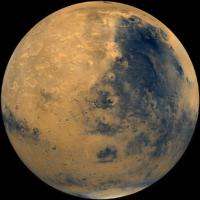STAR TRAK for January

(PhysOrg.com) -- Once every 26 months or so, Mars comes closest to Earth in its orbit around the sun. That time has come again. Mars will reach opposition on Jan. 29, meaning it will be opposite the sun in our sky -- rising in the east around sunset, climbing highest in the south around midnight and setting around sunrise. In telescopes and binoculars, Mars will appear bigger and brighter than it will again until 2012. The red-orange planet will not be as large as it looked during its record-close approach in August 2003.
Jupiter will set nearly four hours after the sun at the beginning of January, shining fairly high in the southwest as the sky grows dark. By month's end it will be much lower and will set soon after the end of twilight for those watching at mid-northern latitudes.
Mercury, the smallest planet, will pass between the sun and Earth on Jan. 4 and then move quickly into the morning sky. It may be visible by Jan. 13, when it will be very low in the southeast a half hour before sunrise. Mercury will brighten more and climb a little higher each morning for the rest of the month.
Venus, the brightest planet, will be out of sight all month as it passes behind the sun. On Jan. 11 it will be on the far side of the sun from Earth.
Saturn will rise in the east around 11:30 p.m. local time at the start of the month and two hours earlier by month's end. It will be highest in the hours before the start of morning twilight, the best time for viewing its rings. The rings will be tilted nearly five degrees toward Earth on Jan. 8, before they gradually start to close again over the next few months. Saturn's largest moon, Titan, will appear close to the planet on Jan. 2, 10, 18 and 26.
Meteor shower
The Quadrantid meteor shower will be active for the first week of January and will have peaked during the frigid hours before dawn on Jan. 3. Unfortunately, a bright moon will wash out all but the brightest meteors this time around. The rate of this shower varies considerably and unpredictably from year to year, but observers may see up to 100 meteors per hour during the brief peak.
The Quadrantids will appear to come from a point called the radiant near the end of the handle of the Big Dipper, which will rise in the northeast. The radiant is in the constellation Bootes the Herdsman, which contains the bright orange star Arcturus as a conspicuous marker.
Try facing northeast toward the Big Dipper. If you extend the curve formed by the handle's three stars, it forms an "arc to Arcturus." Meteors should be visible in all parts of the sky, but the higher Arcturus is above the eastern horizon, the more meteors there will be. More information about viewing meteor showers, including the Quadrantids, is available from the American Meteor Society at www.amsmeteors.org/showers.html .
Perihelion
On Jan. 2 Earth reached the closest point to the sun in its orbit, the position called perihelion. A popular misconception is that our seasons are caused by Earth's changing distance from the sun. The actual cause is the tilt of Earth's axis. Winter in the Northern Hemisphere happens when the North Pole is tilted away from the sun, so that sunlight must pass through a greater amount of Earth's atmosphere to reach the surface. We experience the coldest time of year when we are closest to the sun.
Moon phases
The moon will be at third quarter on Jan. 7, new on Jan. 15, at first quarter on Jan. 23 and full on Jan. 30.
Provided by Indiana University





















